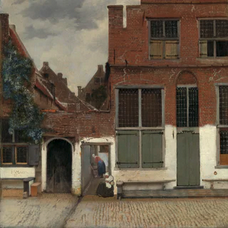Vermeer First painted the House in his Famous Painting "The Little Street" with a closed Door

Johannes Vermeer initially painted the house in his renowned painting The Little Street (c. 1658–1659) with the door closed.
Also discovered is that the woman now seated in the doorway is a mirrored copy of the figure he at first placed at the alley’s entrance to the alley to the left of the house. These new findings add to the previously known changes Vermeer made, such as the addition of the red shutter on the right and the children playing on the doorstep. All of this is detailed in the new book Closer to Vermeer: New Research on the Painter and His Art, published to mark the 350th anniversary of Vermeer’s death. The book is the result of extensive, multidisciplinary research on Johannes Vermeer and his working methods, carried out before, during, and after the Vermeer exhibition at the Rijksmuseum in 2023.
“By literally opening the door, Vermeer makes the scene accessible to the viewer. These and the many other new discoveries in the book paint a picture of a dedicated artist constantly striving to perfect his paintings." -- Pieter Roelofs – Head of Fine Arts, Rijksmuseum

Johannes Vermeer, View of Houses in Delft, Known as ‘The Little Street’, c. 1658–1659. Gift of H.W.A. Deterding, London
The research was conducted by scientists, conservators, and curators from institutions including the Rijksmuseum, the Mauritshuis in The Hague, the National Gallery of Art in Washington, The Frick Collection and The Metropolitan Museum of Art in New York, the National Gallery in London, and the University of Antwerp.
Earlier in this same study, it was discovered that in The Milkmaid, Vermeer had initially included a jug holder and a fire basket, but later painted them out. Using the latest research techniques, we now know that 30 of the 37 paintings attributed to Vermeer show changes, ranging from subtle corrections to radical alterations in composition and meaning. These findings offer new insights into Vermeer’s working methods, use of materials, and painting technique.
Thanks to research by various art historians, new sources and archival documents have surfaced, offering fresh insights into Vermeer’s personal life, his patrons, and the objects he depicted.
A brief overview:
• In Diana and her Nymphs (Mauritshuis, The Hague), Vermeer originally painted an ornate quiver with arrows lying on the rock to the left of the goddess Diana. This quiver bears striking similarities in design and colour to the one at Cupid’s feet in Girl Reading a Letter at an Open Window (Gemäldegalerie Alte Meister, Dresden), which Vermeer painted a few years later.
• The wide brim of the black hat worn by the officer in Officer and Laughing Girl (The Frick Collection, New York) was originally adorned by Vermeer with several lavish, colourful feathers.
• The open book — and even the exact page — in Allegory of the Catholic Faith (The Metropolitan Museum of Art, New York) has now been identified as The Life of Hugo in Generale Legende der Heyligen met het leven Iesu Christi ende Marie by Pedro de Ribadeneira and Heribert Rosweyde (third edition, 1640).
• Research into Vermeer’s use of blue and green pigments shows that his application of these colours changed over the course of his career. This suggests revisiting the chronology of some of his works.
• A newly discovered document bearing Vermeer’s signature proves that he actively acted as a representative for his in-laws, the Thins-Bolnes family, managing their lands in Oud-Beijerland.
• Two newly discovered documents point to Maria de Knuijt, rather than to her husband, as Vermeer’s principal patron, who actively supported his work.
Main Image: Digital visualization of the possible initial composition of The Little Street. F. Gabrieli, A. Krekeler, A. van Loon, I. Verslype/Rijksmuseum
